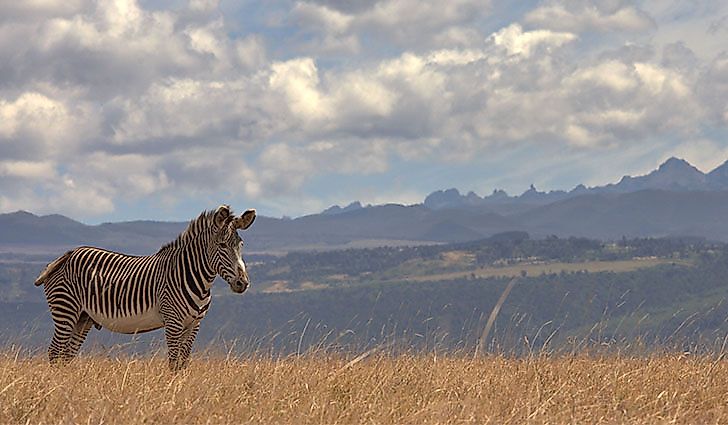Kenya Prepares For The Great Grevy's Rally

The Grevy's zebra is in great danger. A much rarer cousin of the plains zebra, the Grevy's zebra is found in northern Kenya and parts of northeastern and southern Ethiopia. The species is designated as "endangered" by the IUCN Red List as the population has declined by over 81% between the late 1970s and the present day. To help protect the species, Kenya's Grevy's Zebra Technical Committee conceived of the idea of the Great Grevy’s Rally, or GGR. The GGR is a unique way to monitor populations of endangered species.
What Is the Point of the Great Grevy’s Rally?
The GGR is a photographic census conducted over two days in northern and central Kenya to estimate the population of the Grevy’s zebra.
Kasmira Cockerill, the event organizer of GGR 2018, informed World Atlas about the goals of the event.
“The event has three main goals,” she explained. “The first goal is to collect valuable census information to help save the endangered Grevy’s zebra. The second goal is to engage Kenyans and international tourists alike in a conservation activity which has a tangible value for Kenyan wildlife. The third goal is to promote adventure tourism in critical wildlife areas, including the community conservancies of northern Kenya.”
The GGR will also help study the distribution of the Grevy’s zebra across a landscape that is shared with pastoral communities. The data and information generated from the census will also aid the government and conservation stakeholders to make informed decisions to protect the iconic species.
A Brief History of the Great Grevy’s Rally
The first GGR was held in 2016 from January 30 to 31 in northern Kenya. It demanded an enormous effort as the range of the Grevy’s zebra in the region exceeds 25,000 square km. The range was divided into 45 blocks and separate teams were assigned to each block. The GGR participants included people from different walks of life including conservancy members, academic scientists, rangers and scouts from national parks and reserves and conservancies, government officials from the KWS and the counties, and also members of the public.
The participants drove around their respective blocks photographing the zebras using GPS enabled cameras. The photographs were analyzed by the IBEIS/WILDBOOK hotspotter team at Princeton University using a sophisticated stripe recognition software. Individual zebras were identified by their unique pattern of stripes, just like the fingerprints of humans that are unique to each person. Of the over 40,000 images submitted for analysis, 15,246 images were of good quality and had the zebras facing in the "right" direction, a prerequisite for the census. Following analysis and extrapolations for areas that were not surveyed (due to dangers and remoteness), the Grevy’s zebra population was estimated to be 2,350. The figures indicated a stable and healthy population with a strong reproductive potential. The census results were announced on September 3 of the same year at the Great Grevy's Ball hosted at Nanyuki’s Mount Kenya Safari Club.
Speaking of the success of the first GGR, Ms. Cockerill says, “The 2016 Great Grevy’s Rally exceeded our expectations. We had over 350 volunteers and partners take over 40,000 photographs. So many photos were captured that the scientists actually had to rewrite the algorithm to accommodate all of them. With this information, the scientists estimated the most accurate (Grevy's zebra) census we have to date."
The Great Grevy’s Rally 2018
The GGR is set to be hosted on January 27 and 28, 2018. This time, the event’s activities will be extended to include the reticulated giraffe, a species that has been labeled as "vulnerable" by the IUCN, and who shares its range with the Grevy’s zebra. Over the past 30 years, the reticulated giraffe population has also plummeted drastically by about 80% from 36,000 to 8,700.
The GGR 2018 will record the number and distribution of Grevy’s zebras and reticulated giraffes across their habitat in the Meru, Marsabit, Laikipia, Isiolo, and Samburu counties of Kenya.
GGR 2018 is supported by the Grevy's Zebra Trust, IBEIS, Kenya Wildlife Service, Laikipia Wildlife Forum, Mpala Research Centre, Lewa Wildlife Conservancy, and many others.
According to Ms. Cockerill, the response to GGR 2018 has been overwhelming.
“Everyone is so excited, the media are keen to come, almost all our sites are booked out, we could not be happier,” she says.
Although the last census of the Grevy’s zebra painted a bright picture of the status of the species’ population in Kenya, recent devastating droughts and conflicts across large parts of the range of the animal could have adversely impacted the population of the species.
This year's Great Grevy's Rally takes place on January 27 and January 28, 2018. Visit the GGR's website to learn more.
**
Dr. Oishimaya Sen Nag is a freelance writer and editor from Kolkata, India. She loves to participate in wildlife conservation activities and to explore new places and cultures.











